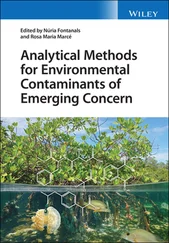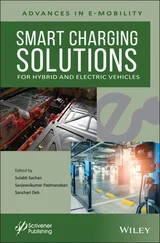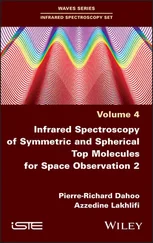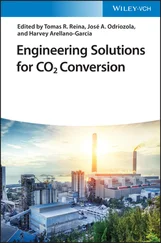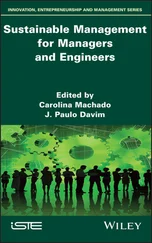In order to face these socio-environmental challenges, without aggravating the situation through the introduction of disruptive technologies, the European Commission promotes the use of management methods inspired by natural processes: nature-based solutions (NBS). The European Commission defines NBS as: “ Solutions that are inspired and supported by nature, which are cost-effective, simultaneously provide environmental, social, and economic benefits and help build resilience ” (Faivre et al. , 2017). The chapter focuses mainly on publications from the last 20 years devoted to the NBS implementation in bioremediation in water environment.
1.2 Basic Principles
1.2.1 Bioremediation
Strictly speaking, the term bioremediation encompasses a set of remediation technologies based on the use of living organisms to degrade or extract pollutants from the waterbodies. Bioremediation technologies stimulate the natural processes of biodegradation (self-purification) and clean the polluted environment. They can be applied directly on site in the case of in-situ bioremediation, treating the contaminant on site, or remotely in the case of ex-situ bioremediation, where the contaminated soil or water is extracted for treatment at a facility near the polluted site, or elsewhere after transportation (EPA, 2013). Bioremediation techniques are sustained by natural processes of a physical-chemical and/or biological character by exploiting the natural purification capacities of living systems: NBSs, applied separately or in synergetic way (Daghio et al. , 2017; Lofrano et al. , 2017).
Whether they are physical-chemical, microbial- or plant-assisted, or both, all bioremediation techniques involve oxidation-reduction reactions. Indeed, the common denominator for all NBSs applied to bioremediation is the addition of sufficient electron acceptors or donors to oxidize the pollutant or to stimulate the living organisms that will oxidize the pollutant.
Self-purification is a natural biogeochemical process occurring in any ecosystem, and leading to elimination or assimilation of OM, mineral nutrients, or other pollutants by the natural activity of its resident biological communities (Namour, 1999; Marmonier et al. , 2012). It is particularly active in the river underflow (hyporheic zone) where large contact surfaces develop and a redox gradient naturally installs (Namour, 1999; Namour and Le Pimpec, 2001). Its effectiveness depends on several factors such as the amount and toxicity of the contaminant, its ability to be degraded or “biodegradability” according to the surrounding physical-chemical conditions.
Biodegradability is the ability of substances to be decomposed into simple chemical elements, by the enzymatic activity of living organisms, mainly microorganisms. In fact, biodegradation is a dynamic balance between more or less complex chemical structures of varying resistance (more or less biodegradable), and the action of physical-chemical and biological agents. The quality and quantity of OM present and the existence of specific enzymes dictate the nature and intensity of biodegradation. Thus, biopolymers such as lignins or geopolymers such as humic substances are refractory to biodegradation due to the absence of specific degradation enzymes and require the prior intervention of redox enzymes that produce free radicals capable of opening aromatic cycles (Lipczynska-Kochany, 2018).
Sediment is generally oxygen poor (low diffusion and rapid consumption by microorganisms) and overloaded in OM, so microbial metabolism maintains reducing conditions in sediment where the biodegradation reactions take place according to a redox gradient ( Figure 1.1) (Bertrand et al. , 2011). Biodegradation effectiveness is often limited by the low availability (presence and mobility) in electron acceptors [e.g., 
 In such environment, microbial activities maintain reducing conditions in the porous sediment and the biodegradation reactions are gradually moving along the redox gradient (Borch et al. , 2010). In addition, environmental conditions affect the microbial metabolic pathway: 1) temperature strongly drives the biological activities; and 2) OM and NO 3 -(exogenous inputs or NH 4 +nitrification) availabilities are main reactants for denitrification (Lefebvre et al. , 2004). The redox potential is a key element closely related to the pH and the electron acceptor availability ( Figure 1.1).
In such environment, microbial activities maintain reducing conditions in the porous sediment and the biodegradation reactions are gradually moving along the redox gradient (Borch et al. , 2010). In addition, environmental conditions affect the microbial metabolic pathway: 1) temperature strongly drives the biological activities; and 2) OM and NO 3 -(exogenous inputs or NH 4 +nitrification) availabilities are main reactants for denitrification (Lefebvre et al. , 2004). The redox potential is a key element closely related to the pH and the electron acceptor availability ( Figure 1.1).
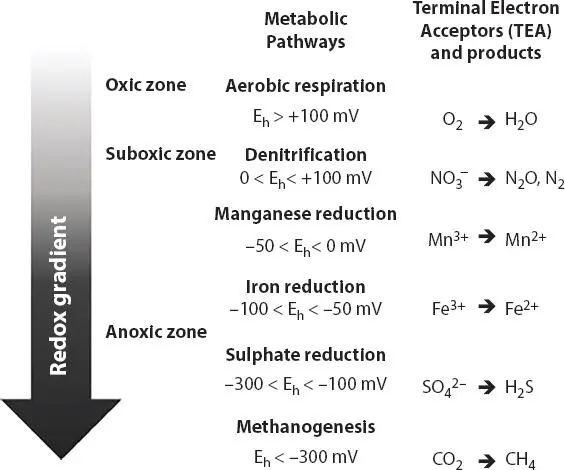
Figure 1.1 Schematic organization of different microbial metabolic pathways in the water systems according the redox potential. The order of terminal electron acceptors (TEA) displayed in an idealized system is  Fe(III), Mn(IV),
Fe(III), Mn(IV),  and CO 2. Adapted from Bertrand et al. (2011; p. 573), Diaz and Rosenberg (2008), and Hargrave et al. (2008).
and CO 2. Adapted from Bertrand et al. (2011; p. 573), Diaz and Rosenberg (2008), and Hargrave et al. (2008).
If aerobic micro-organisms breathe O 2as terminal electron acceptor (TEA), anaerobic micro-organisms breathe other TEAs, as  or OM, producing noxious gases such as CO 2, CH 4, N 20, H 2S, and NH 3(Bertrand et al. , 2011). These TEAs yield lower energy than O 2, so anaerobic respiration is less energy efficient and anaerobes grow slower than aerobes. Low TEA availability (presence and mobility) often limits self-purification process.
or OM, producing noxious gases such as CO 2, CH 4, N 20, H 2S, and NH 3(Bertrand et al. , 2011). These TEAs yield lower energy than O 2, so anaerobic respiration is less energy efficient and anaerobes grow slower than aerobes. Low TEA availability (presence and mobility) often limits self-purification process.
NBSs of bioremediation aim at optimizing the TEA input needed to on-site self-purification. To do that, they implement three nested logics: action on form or physical structuration of the environment; action on fluxes of water and substances through it; and action on biocenosis living in the ecosystem. Thus, NBSs act on the geomorphology, hydrology, and physical-chemical characteristics of the environment such as in constructed wetlands (CWs) or filtering banks (FBs); on living organisms such as plants in phytoremediation; or on microbial consortia by passive control of the redox potential by supplying electrochemical inexhaustible TEAs in electro-bioremediation.
1.2.2.2 Photo-Degradation
Photo-degradation is an oxidation of organic compounds induced by solar radiation, mainly by the energetic part of the solar spectrum, i.e., the ultraviolet (UV) radiation. Aquatic OM is photo-chemically unstable under ambient sunlight. In a wetland, according to its chemical structure, OM can be subjected to solar radiation, leading to its photolysis (fragmentation into lower molecular weight molecules, more easily assimilated by microorganisms), photo-bleaching (decrease in UV-visible absorbance due to loss of aromaticity), and photo-mineralization (complete degradation into mineral elements). Organic micropollutants are susceptible to be degraded by photolysis, with a large range of half times, from a few days to several months (Avetta et al. , 2016). This degradation is only partial, therefore, the by-products are likely to be other organic molecules, of smaller size and not fully oxidized end-products such as H 2O, CO 2, and NO 3 -. In the case of sulfamethoxazole (SMX), a widely used antibiotic in human healthcare and its human metabolites (86% of the ingested SMX dose), most metabolites were found to be photostable under environmentally relevant conditions. The degradation yields, based on carbon balance, reached 90% for SMX after 4 hours, but only 50% for N-acetyl SMX, the main human metabolite (50% of the ingested SMX dose) (Bonvin et al. , 2013). The effect of solar irradiation is both direct and indirect: indirect photolysis refers to the action of hydroxyl and carbonate radicals and excited triplet states of dissolved OM formed in the water phase by solar irradiation.
Читать дальше
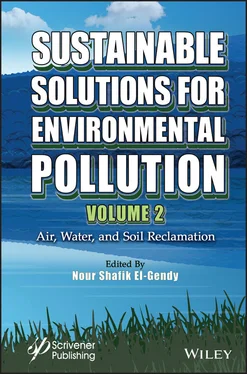

 In such environment, microbial activities maintain reducing conditions in the porous sediment and the biodegradation reactions are gradually moving along the redox gradient (Borch et al. , 2010). In addition, environmental conditions affect the microbial metabolic pathway: 1) temperature strongly drives the biological activities; and 2) OM and NO 3 -(exogenous inputs or NH 4 +nitrification) availabilities are main reactants for denitrification (Lefebvre et al. , 2004). The redox potential is a key element closely related to the pH and the electron acceptor availability ( Figure 1.1).
In such environment, microbial activities maintain reducing conditions in the porous sediment and the biodegradation reactions are gradually moving along the redox gradient (Borch et al. , 2010). In addition, environmental conditions affect the microbial metabolic pathway: 1) temperature strongly drives the biological activities; and 2) OM and NO 3 -(exogenous inputs or NH 4 +nitrification) availabilities are main reactants for denitrification (Lefebvre et al. , 2004). The redox potential is a key element closely related to the pH and the electron acceptor availability ( Figure 1.1).
 Fe(III), Mn(IV),
Fe(III), Mn(IV),  and CO 2. Adapted from Bertrand et al. (2011; p. 573), Diaz and Rosenberg (2008), and Hargrave et al. (2008).
and CO 2. Adapted from Bertrand et al. (2011; p. 573), Diaz and Rosenberg (2008), and Hargrave et al. (2008). or OM, producing noxious gases such as CO 2, CH 4, N 20, H 2S, and NH 3(Bertrand et al. , 2011). These TEAs yield lower energy than O 2, so anaerobic respiration is less energy efficient and anaerobes grow slower than aerobes. Low TEA availability (presence and mobility) often limits self-purification process.
or OM, producing noxious gases such as CO 2, CH 4, N 20, H 2S, and NH 3(Bertrand et al. , 2011). These TEAs yield lower energy than O 2, so anaerobic respiration is less energy efficient and anaerobes grow slower than aerobes. Low TEA availability (presence and mobility) often limits self-purification process.